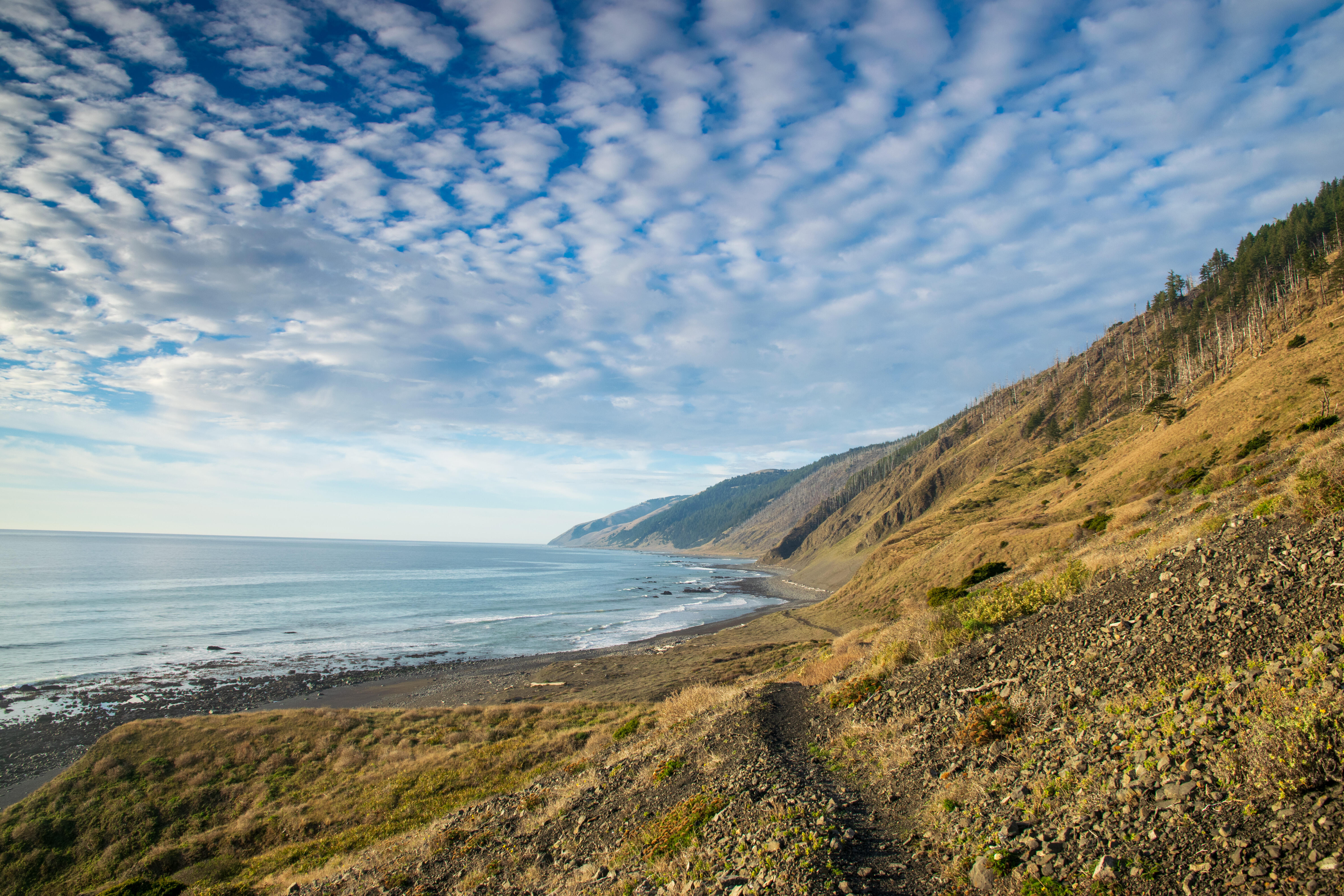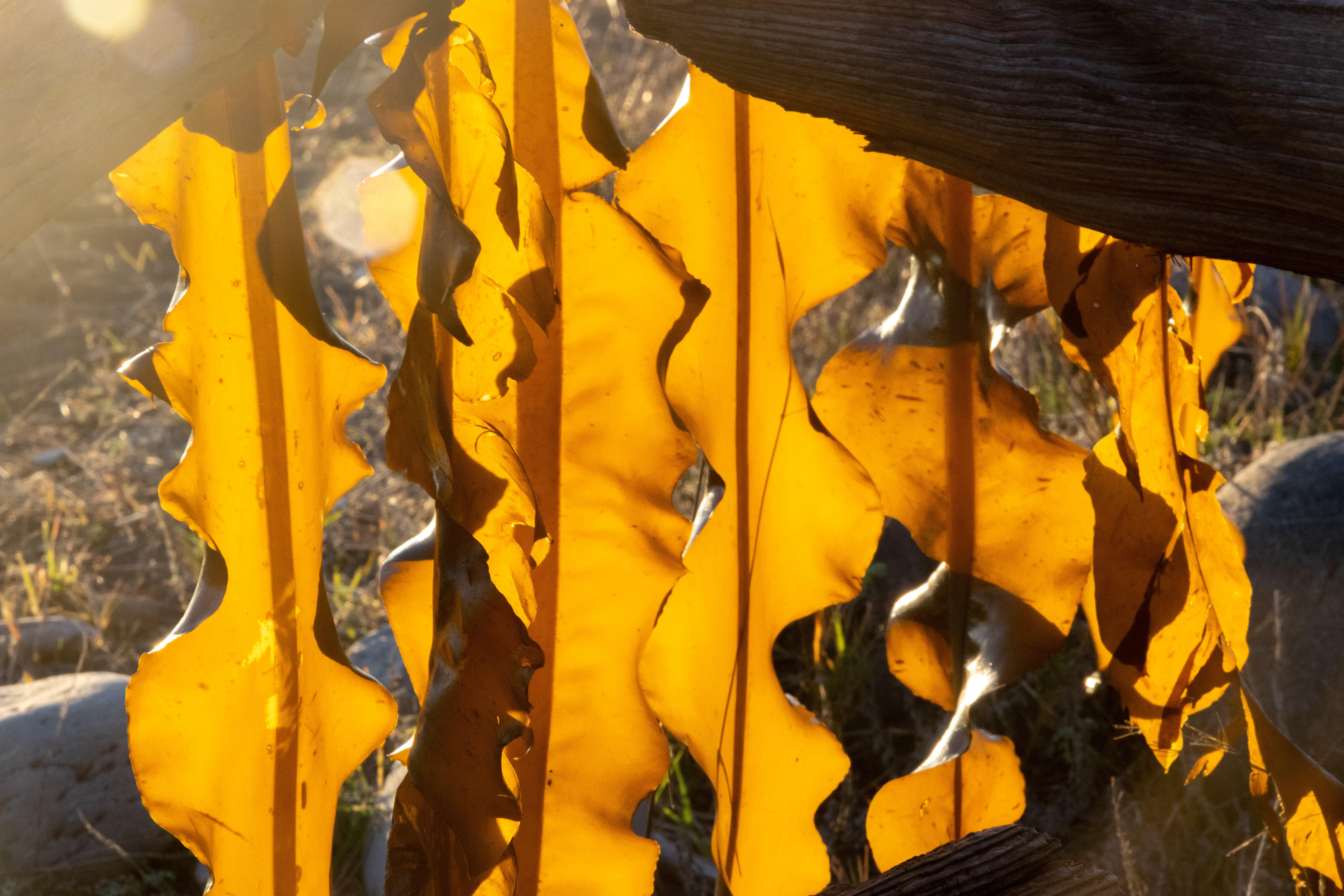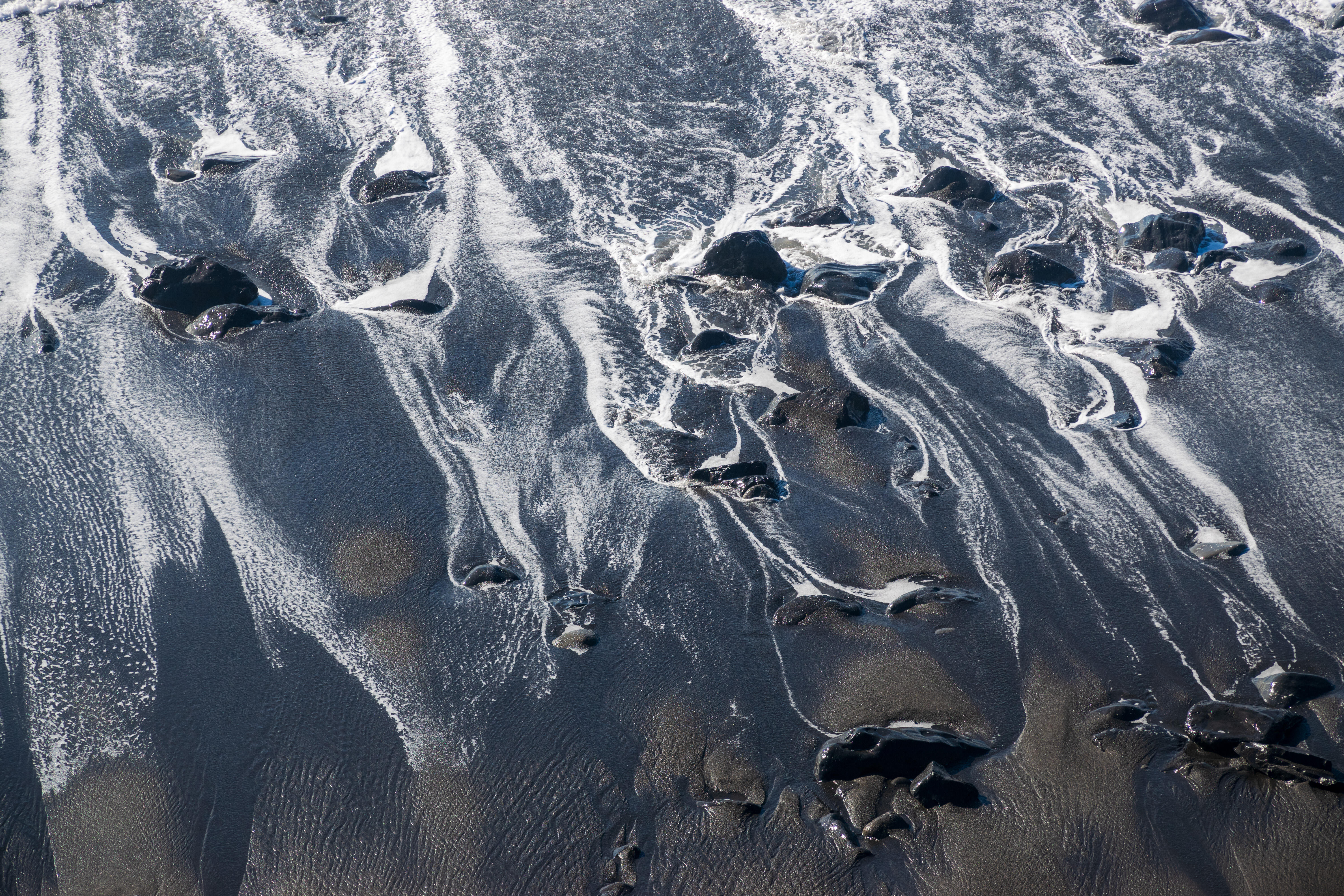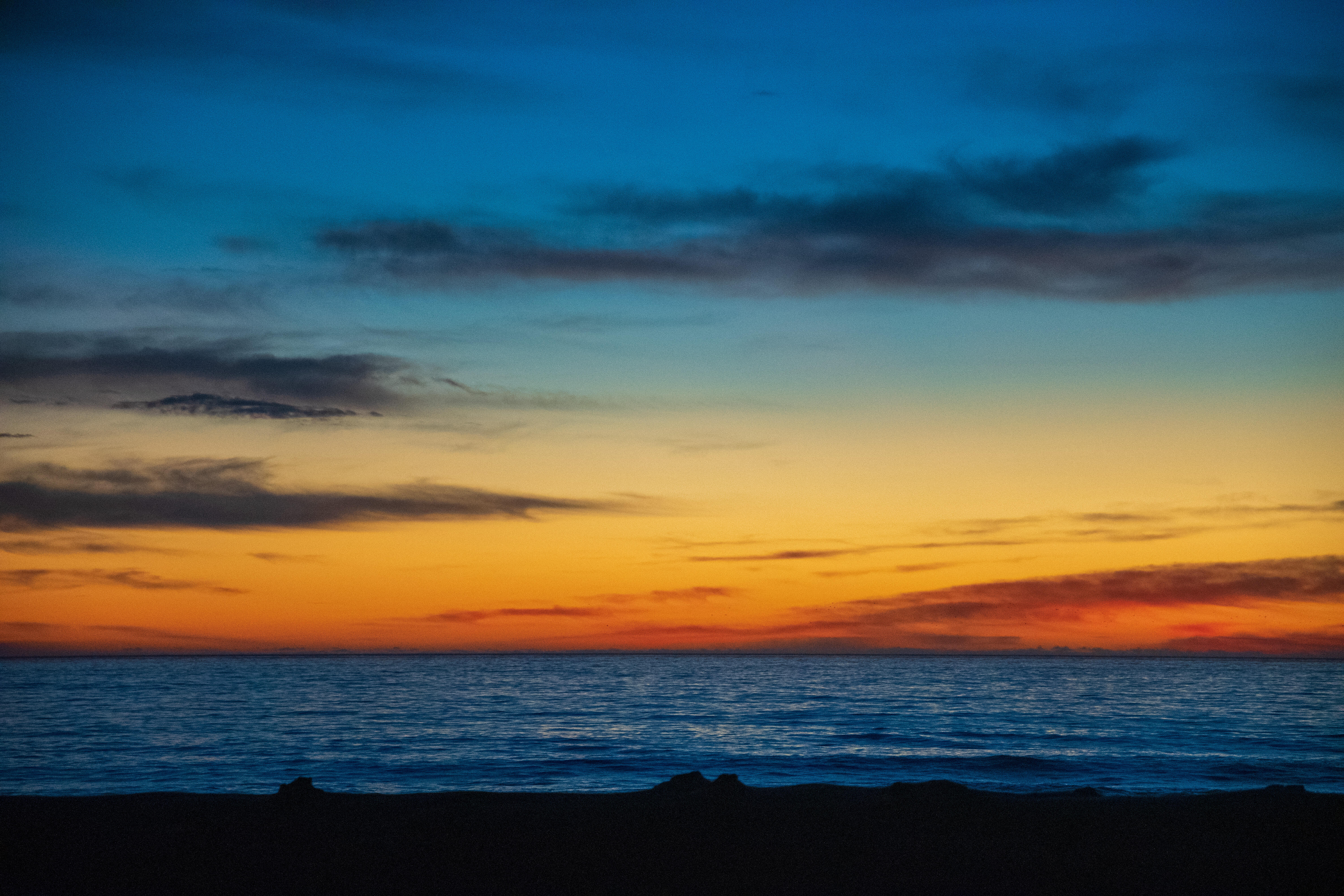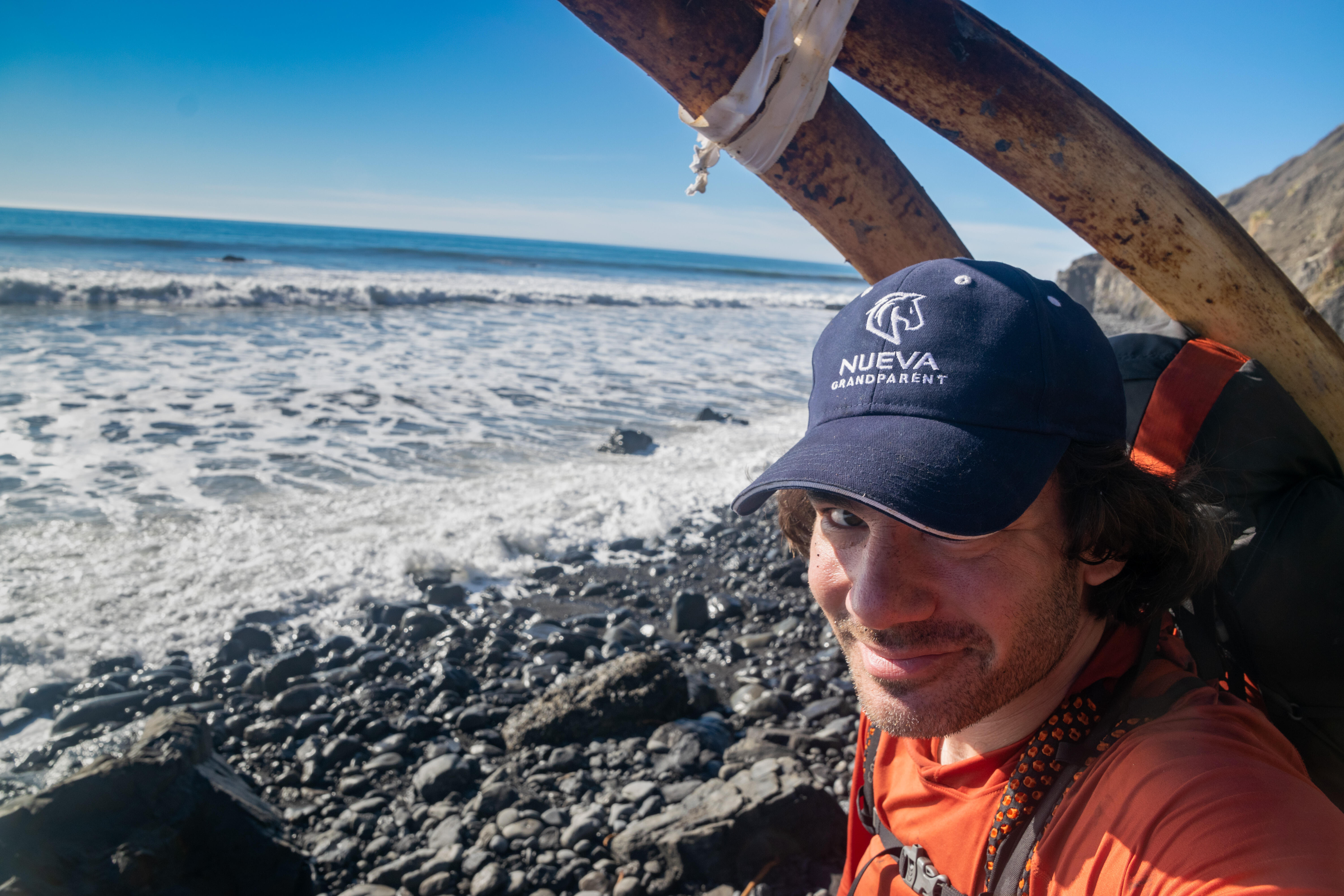The Lost Coast
Thursday, 24 November 2022
Along Highway 101 somewhere between Ukiah and Eureka
It’s Thanksgiving, 10 PM, and I’m at a rest stop 200 miles north of San Francisco. There’s rotting whale flesh in the back of my car. I just bought the car a week ago. Outside the air is thick with the smell of campfires and Douglas fir. Inside, the new car smell is decisively gone.
(This is my 2022 holiday letter. Merry Christmas!)
I’m driving back to Palo Alto after four days solo backpacking the Lost Coast. Have I been on a better backpacking trip? In 35 years? Maybe not.
I saw sea lions and bald eagles and surfer bros. I foraged for mussels and seaweed and roasted them over campfires. I filtered my water but the water found different ways to try to kill me. I napped in lean-tos made out of driftwood. I did yoga routines on top of bluffs. I saw amazing sunsets and amazing fog and I was overwhelmed, emotionally, by all of it.
There’s a joke about the climber Peter Croft: “What’s Peter Croft’s favorite climb? Whatever he climbed most recently.” Maybe that’s true of me. But still! Guys! This was so great.
The Lost Coast is the only section of the American West Coast too rugged for a road. The Pacific Coast Highway starts at the Mexican border and bounds confidently up the beach for 800 miles. Then it hits Humboldt County. It gives up, turns 25 miles inland, and doesn’t get salt-sprayed for another 100 miles. That’s the Lost Coast. You can’t drive it in your Tesla. But you can hike it in your trail runners.
Maybe.
The hike is along the beach. Half of it is below the high tide line. You have to time yourself right with the tides. Otherwise you get dragged out to sea or bashed to pieces against the cliffs.
The hike is flat, but the terrain is nontrivial. Talus, gravel, sand. You might as well go for a walk on a planet with twice the gravity. Orthopedically, there’s only one outcome. Either you exit with ankles of steel, or ankles needing pins of titanium.
It’s beautiful. The last gasps of California interspersed with the first glimpses of the Pacific Northwest. Golden, rounded hills covered with chaparral and scrub, and then, a mile later, jagged mountainsides forested thick in redwood and Douglas fir. Just before the abandoned lighthouse at Punta Gorda—the northern terminus of the trail—is a single, very tall, very out-of-place agave.
Hiking north, the coast is continually convex. It always looks like you’re about to round a headland. The horizontal equivalent of a false summit.
Most people hike one way. 25 miles over three or four days. They drop cars or pay for a shuttle back. That seemed like a lot of work (and expensive), so I just hiked the whole thing out and back. 50 miles over four days. Twice the fun for way less hassle (and cost).
I went tidepooling every day. I foraged for mussels. I ate mac’n’cheese with fresh, campfire-roasted California mussels. I foraged for seaweed. I ate ramen with a packet of instant miso, a tin of salmon from Trader Joe’s, and fresh nori. I smoked strips of wakame and bullwhip kelp over the fire. I saw obese orange starfish and eerie green anemones. On the beach I saw abalone shells, shimmering and iridescent.
I rounded a corner to see a bald eagle perched on a rock 25 feet away. It took off immediately, and spent the next ten minutes circling 100 feet overhead, engaged in an ambiguous dance with a raven. They weren’t aggressive with each other, but neither did they ignore each other. I bit my lip and my heart pounded in awe. I rounded another corner and startled a juvenile sea lion splashing in a stream a few yards up from the surf. He (she? they?) took off into the waves, but we spent the next 20 minutes going up and down the beach together, them in the surf, me on the sand, back and forth, both of us rarely taking our eyes off each other.
Cormorants and ravens everywhere. (Deer, too.) Bald eagles. A juvenile bald eagle with whom I hiked for a mile. They perched on driftwood 200 feet ahead of me, updating every minute or two. Sea lions lazily bobbing up and down in the surf every few hundred feet. Offshore rocks draped in barking sea lions. Beaches carpeted in harbor seals. An ancient, mottled seal, hauled way up past high tide, all alone, staring at me sadly through cataracts. An oil tanker of an elephant seal, shipwrecked snoozing on the beach. The outline of an otter, crawling across talus.
At golden hour, in a small lagoon on a creek behind a sandbar: dozens of tiny jumping fish, making backflips at random moments and places. Fireflies of the littoral. I stared until it was too dark to see them anymore.
The mouth of a giant fish. Twelve inches across. Just the mouth: the upper and lower jaws, the upper teeth, some scraps of flesh, and nothing else. The jaws still hinged open and shut. It was lying agape on the beach.
Driving away from the trailhead in the dark after finishing: two gray foxes slowly crossing the road and then ambling alongside it. Gray foxes are my favorite species of fox, but they’re way more skittish than reds, and I’d never seen them in the wild so close for so long. I shined my headlamp on them. They didn’t care. They just kept walking. Gotta get some miles in.
I was too aggressive on my last day. The tide hadn’t receded quite far enough when I set out and a huge wave roared in. Water up to my thighs, foam over my head; I was pinned against the cliff, terrified, with no exit. Another day I had to hike late into the night (the only way to make the timing work). In the dark I tripped into a tidepool and only just in time airbagged my face onto my forearm. I pulled my headlamp out, reluctantly, but the fog was so thick that I still couldn’t see anything. I could feel the cliff a few feet to my left and hear the waves pounding not enough feet to my right.
Timing the hike with the tides was the hardest part for me—not logistically, but psychologically. I’m deep in the goal-oriented thru-hiker mindset of gotta get some miles in. Always moving, as fast as possible, all the time. But on this trip I couldn’t do that. I was forced, at points, to slow down and stop. So I was able to pay more attention to my surroundings and to be more in the moment. At other points I had to speed up, and was prevented from being lazy.
(The contrast between idly sitting sipping tea reading Turgenev on a bluff while waiting for the tide to go out, and booking it down the beach as fast as possible before the tide comes back in.)
In that sense, the entire hike was a counterpoint to atomic individualism. Waiting for the tides to turn isn’t about individual choice and self-determination. It’s about submission to the external (the earth, the environment, the waves, the water). To some extent that’s always true outdoors (as everywhere else), but here there was something I’ve always done (go as long and as far as I want) that I was no longer able to do.
You don’t even have individual choice and self-determination about your poops. In that case the external authority you submit to isn’t the gravity of the moon, but rather the Bureau of Land Management, which only lets you poop on the beach at low tide. I had to time not just my hiking, but my digestion. But what views! What dramatic spots! The poops I’ve taken on the sides of cliffs haven’t been this exposed.
The waves are relentless. Six to ten feet, twenty-four hours a day, pounding and pounding and pounding.
On the gravel beaches, when the gravel was finger- to fist-sized, not only were there the normal sounds (water against water, water against land), but there was the sound of all that water draining out through the gravel. Like the rainsticks we played with in preschool—the empty cylinders filled with fixed thorns and beans that rain down as you rotate them.
I camped one night next to a stream and as I was trying to sleep I couldn’t stop focusing on how the static noise of the stream was at a different, higher frequency than that of the ocean.
The last line of A River Runs Through It was pounding in my head: I am haunted by waters.
I met half a dozen people who backpacked shortboards in to surf the less-gnarly breaks. (Still seemed pretty gnarly.) One of them recognized my fancy ultralight tent. “Dude, that’s my favorite tent. It’s so light, and it’s totally bomber in a storm.”
“It’s new,” I said, “at least to me.”
The trip capped off a chaotic few weeks. On top of being slammed with a dozen different things in both work and non-work life (most of them good, or at least neutral), I had been trying to figure out what to do over Thanksgiving. At 5:30 one morning I was idly browsing around, found one available permit for the Lost Coast trail, and snatched it. (Normally all the permits disappear a year in advance.) Then I realized I was finally out of friends to bum cars from (I haven’t had a working car since March), decided that maybe I should be more serious about the casual window-shopping I’d been doing since June, realized that a decent-seeming instantiation of my particular desires had recently arrived at a dealership in San Jose, etc., etc.; frantic 5:30 AM calls to multiple banks (8:30 on the East Coast!); an incident with a runaway Caltrain; anyway, now I have a stick-shift Subaru Forester that’s big enough to sleep in. And, more importantly, that enabled me to go to the Lost Coast.
(For my day-to-day bike-commuting life, a car is a luxury. It’s not a necessity. But mountains aren’t a luxury. Mountains are a necessity.)
I told a colleague about my plans a few days before break. “It’s probably going to rain, so I’ll have to bring my tent. I hate it. It’s so big. It’s so heavy.” He immediately offered to lend his fancy Hyperlite tent (an ultralight pyramid of Dyneema, supported by a single carbon fiber pole).
“The only problem is, you’ll love it so much, you’ll want to go out and buy one of your own.”
“Or I could keep yours.”
There are two or three cabins along the trail—holdouts who never sold to the BLM. One of them has an airstrip. I hiked by just in time to see a tiny Cessna swoop low, turn around, and come back in to land. It took off a few minutes later. Dropping folks off for a secluded Thanksgiving, I guess. Ten minutes after that I heard the roar of another plane, right over my shoulder, and realized the trail was about to go colinear with the airstrip. Had I been 100 feet further down, I would have been a runway strike.
Just south of the airstrip was the whale.
It was lying at the high tide line on the flat sandy beach the surfers were trying to shred. It was deflated and, from more than a few dozen feet away, unrecognizable. It was arranged in a crescent, maybe twenty feet across. I couldn’t figure out what species it was. The spine was at the sand line and the right side was buried. I couldn’t find its head. There was a gash in the abdomen, with ribs and vertebrae sticking out. Almost no soft tissue left. Just leather draped over bones. I saw it on my hike north and it etched itself into my mind. The first time I’ve ever seen a whale in the wild, living or dead.
I stopped to visit it again on my way back.
And I was really, really tempted.
Yesss.
The ribs pulled right out. Like they had been slow-cooked to perfection. But with the tasty bits long gone. And smelling way, way worse.
I scrubbed off the remaining flakes of tissue, rinsed them in the surf, and laid them out to dry. Then I lashed them to my pack, like a 20-pound pair of skis, and hiked out ten miles on soft sand.
I’m not yet sure what I’ll do with them. But! What I’m really excited about is the dozen spinal discs that I ALSO scavenged! When I saw them, scrunched in between the vertebrae, I knew exactly what they wanted to become. This will sound so bougie and banal and Etsyesque, but… they’re the perfect size and shape to be charcuterie boards. I’m so excited. After I degrease and bleach them I’m going to plane down the undersides and finish the topsides and then maybe some of you will get one in the mail! Bone is porous, so I should probably seal them? I no longer believe in polyurethane, but maybe mineral oil would work? Or beeswax? What does one use to seal/treat/condition desiccated whale bone?!?
Anyway.
Here are some more photos. (They’re really good… not to brag.)
I’m sending Christmas cards in a few weeks; I thought about writing a Christmas letter, too, but this is better.
It’s been a normal year. I’ve had lots of successes; I’ve had lots of struggles. The successes have been what they usually are; same with the struggles. Still looking for wisdom. Still trying not to refuse grace. I’ll be 36 in a week. Halfway through—if I’m lucky, God willing.
Happy 2023.
Andrew

